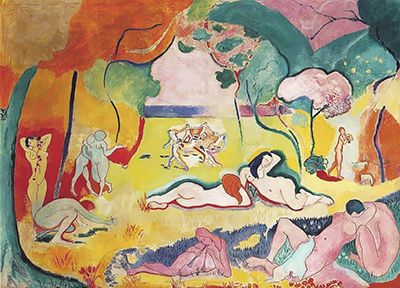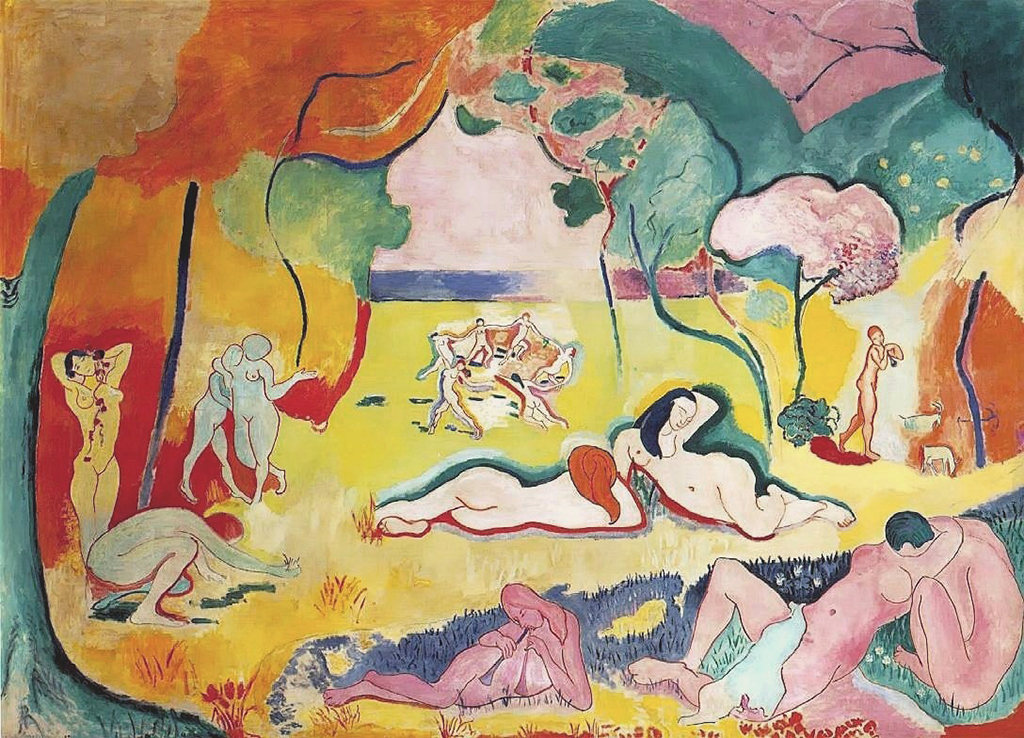Completed in 1906, Henri Matisse finished what is often described as his greatest Fauvist painting, the Bonheur de Vivre, or the 'Joy of Life'.
During his Fauvist years Matisse often painted landscapes in the south of France during the summer where he developed ideas into larger compositions before returning to Paris. The oil on canvas painting Le Bonheur de Vivre is typical of the artist's important imaginary compositions. Starting with a landscape he had painted in Collioure to provide the setting for the idyll, he also drew inspiration from Japanese woodcuts, Persian miniatures, Poussin, and Oriental depictions of harems. Critics noticed that the broad swathes of colour and linear figures were a clear rejection of Paul Signac’s Pointillism style, which had gone before. The vast work and its shocking colours therefore received mixed reviews at the Salon des Indépendants.
Portraying an Arcadian landscape adorned with brilliantly coloured forest, meadow, sea, and sky Le Bonheur de Vivre is populated with dancing and relaxing nude figures. As with the earlier Fauve canvases, the purpose of colour was to directly express emotions and for the formal needs of the canvas, rather than to realistically represent nature. The scene depicted in Le Bonheur de Vivre is an expression of pure pleasure. Here is a fantastical place full of life and love and free from negativity. Instead of a contemporary scene in a park, on the banks of the Seine, or other recognisable places in nature, Matisse has returned to mythic paradise. The painting was purchased by wealthy expatriate American writer and poet Gertrude Stein and her brother Leo. Displaying it in their art filled home in Paris, the location was also where Gertrude's weekly salon took place. Here, Matisse, Apollinaire, largely unknown Picasso and other members of the avant-garde gathered to exchange ideas.
The Fauvist art movement shocked the art critics at times, particularly in its early days. Some claimed that the illuminated colour schemes were an 'assault on the eyes', that could potentially blind the viewer. There was great discussion about whether this was a natural movement onwards from the impressionist artists, or if the movement away from form was too marked. Le Bonheur de Vivre is certainly less abstract than some of his more experimentational pieces of this period, with figures clearly formed and sufficient detail so as to not scare some of the more traditional of his followers. There is much merriment to see right across the canvas, capturing indeed an example of the 'Joy of Life'. We can see a multitude of groups of people in a variety of poses and activities, plus a large amount of landscape elements in which they are mingled.
When first viewing the piece, one is overcome by the cadmium tones which penetrate your eyes with an explosion of colour. The figures across the scene have simple outlines, almost cartoon-like, with the forms then filled in with single colours for each figure. In the background are a group of women dancing merrily in a circle. They are hand-in-hand and this element of the scene will remind many of another work from the same artist, namely Dance. There are then additional figures in personal embraces nearer to the viewer, with them entwined in trees and grass. The far area is purely sand, which eventually reaches the sea. Blue has proven an important colour for many expressive artists and in this painting it is used by Matisse as an outline to several of his trees to signify the trunk.
"...The work is known to have invigorated fellow artists, especially Pablo Picasso, who in an effort to outdo Matisse in terms of shock value, immediately began work on his watershed Les Demoiselles D'Avignon..."
Martha Lucy, Associate Curator at the Barnes Foundation
In recent years, there has been a continued interest in researching this piece. Many have commented that the original brightness is starting to deteriorate, becoming more subtle but also leaving behind the original intentions of Matisse. Scientific research has examined just why this has occurred, and if any efforts can be made to protect the painting for future generations. It has been reported that the yellow regions of the painting were put together using cadmium sulfide-based yellow, but that this was now changing into tones of brown and white. The entire balance of the work would therefore be changed, hence the efforts to protect it more effectively.
"...It is a very disheartening phenomenon, considering the painting's position in history..."
Professor Robert L. Opila, Professor of Materials Science, UD
This can only be described as a huge painting, measured at 176.5 cm × 240.7 cm (69.5 in × 94.75 in). Contemporary art has not tended to give us paintings as large as the masters from the past, and so this can be considered particularly big within the context of its era. It's size ensures that the colour scheme really leaves a big impact behind and it could never be described as a forgettable piece for those fortunate enough to view it in person, whether it is actually to their personal taste or not. Matisse himself did work on large scale canvases throughout his career, and so for him, personally, this was not unusually large.
This dominating artwork can be found in the impressive collection of the Barnes Foundation, Philadelphia, Pennsylvania. They possess one of the finest selections of contemporary art in North America and European artists are particularly well represented. Impressionists and Expressionists can be seen in the form of Amedeo Modigliani and Pierre-Auguste Renoir, plus also Claude Monet and Paul Cezanne. All major contributors from the early Impressionist era up to the 1940s are represented here, leaving an exceptional venue for art enthusiasts to spend considerable hours in awe at some of the most famous paintings in all art history. Within all of this, Matisse’s Le Bonheur de Vivre is perhaps the most significant piece of them all.





